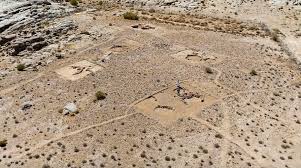Riyadh Monitoring Desk
Saudi Arabia’s Minister of Culture and Chairman of the Heritage Commission Board, Prince Badr bin Abdullah, has announced the discovery of one of the oldest known human settlements on the western side of the city of Tabuk.
According to Urdu News, the archaeological remains are estimated to date back between 10,300 and 11,000 years, corresponding to the transition from the Neolithic era, when humanity began to shift from nomadic lifestyles to more permanent settlements.
The remains were uncovered at a site known as “Masyoun”, as part of a collaborative excavation effort between the Saudi Heritage Commission, Kanazawa University of Japan, and the NEOM project. The site is believed to contain traces of a prehistoric community that thrived during the early Neolithic period.
The location of Masyoun was first included in the National Antiquities Registry in 1978. A comprehensive ground survey began in December 2022, and by May 2024, a total of four surveys had been completed. These efforts included excavations and various forms of archaeological analysis.
The findings revealed semi-circular residential structures constructed using locally sourced granite stones. The remains include houses, alleyways, and various architectural layouts, indicating a planned and organized settlement — a significant marker of early human civilization in the Arabian Peninsula.
Prince Badr emphasized the importance of this discovery in understanding the region’s deep historical roots and the pivotal role it played in the development of human society. The collaboration with international institutions like Kanazawa University highlights Saudi Arabia’s commitment to uncovering and preserving its rich cultural heritage.
This discovery adds to the growing body of evidence positioning Saudi Arabia as a key location in the study of ancient human history, especially in relation to early settlements and transitions in human civilization.
.


